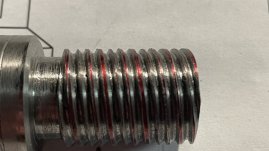mitchapalooza88
Plastic
- Joined
- Apr 17, 2018
Hi all looking for some advice from the group. I’ve tried a couple times without success to cut a multistart thread and wanna reach out. I may be missing something in my setup or my math could be wrong.
I’m looking to cut a .75”dia 3 start 60° thread with a 4 tpi lead. So that should be a 12 tpi thread. I have the compound set to 90° and I use 0 - .083 -.166 for each thread cut set from the compound (each thread start progressing by the pitch). I am making my cuts with the cross slide to a double depth of .108.
When I do a scratch pass for the three it seems to line up perfect but after the first start is cut it looks off. And if I keep going it ends up getting skewed.
My only guess is that maybe the aggressive tpi is actually pulling my compound slide? As I don’t have a way to lock it.
I’m looking to cut a .75”dia 3 start 60° thread with a 4 tpi lead. So that should be a 12 tpi thread. I have the compound set to 90° and I use 0 - .083 -.166 for each thread cut set from the compound (each thread start progressing by the pitch). I am making my cuts with the cross slide to a double depth of .108.
When I do a scratch pass for the three it seems to line up perfect but after the first start is cut it looks off. And if I keep going it ends up getting skewed.
My only guess is that maybe the aggressive tpi is actually pulling my compound slide? As I don’t have a way to lock it.



